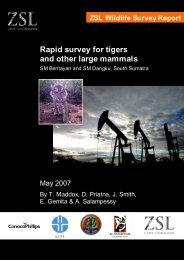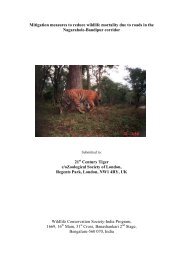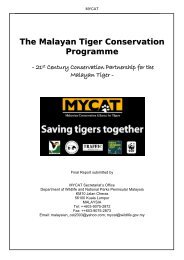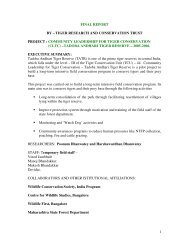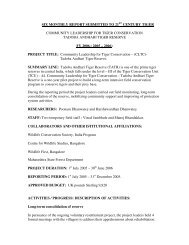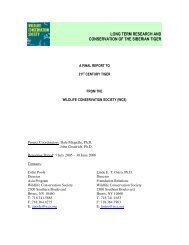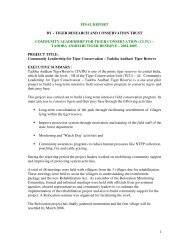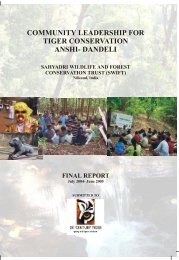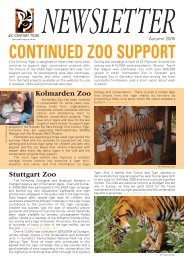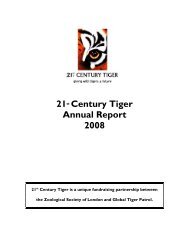The conservation of tigers and other wildlife in oil palm plantations
The conservation of tigers and other wildlife in oil palm plantations
The conservation of tigers and other wildlife in oil palm plantations
Create successful ePaper yourself
Turn your PDF publications into a flip-book with our unique Google optimized e-Paper software.
Table 1 - Limitations <strong>of</strong> national parks<br />
Limitation Explanation<br />
Size Because they compete with human requirements for l<strong>and</strong>, national parks are<br />
always limited <strong>in</strong> size which restricts their capacity to support wide-rang<strong>in</strong>g<br />
species e.g. <strong>tigers</strong> <strong>and</strong> elephants<br />
Distribution Because <strong>of</strong> human l<strong>and</strong> requirements, national parks are generally <strong>in</strong> areas less<br />
favoured by people, such as mounta<strong>in</strong>s or swamps. Some habitats, such as<br />
lowl<strong>and</strong> forest <strong>in</strong> Indonesia, are poorly represented.<br />
Edge effects With limited size comes an <strong>in</strong>creased edge effect, the impact <strong>of</strong> ‘<strong>conservation</strong><br />
unfriendly’ l<strong>and</strong> surround<strong>in</strong>g national parks, which can suck <strong>wildlife</strong> out <strong>of</strong> the<br />
park <strong>in</strong> a source-s<strong>in</strong>k relationship<br />
Connectivity Due to the limitations on their physical placement <strong>and</strong> the impacts <strong>of</strong> surround<strong>in</strong>g<br />
l<strong>and</strong>, national parks are frequently a cha<strong>in</strong> <strong>of</strong> isolated ‘isl<strong>and</strong>s’ <strong>of</strong> <strong>conservation</strong>. This<br />
can have important effects on their capacity for <strong>wildlife</strong> survival. <strong>The</strong>re may be<br />
several hundred <strong>tigers</strong> with<strong>in</strong> Indonesia’s national parks, but many <strong>of</strong> them are<br />
likely to be liv<strong>in</strong>g <strong>in</strong> populations <strong>of</strong> only a few tens <strong>of</strong> <strong>in</strong>dividuals.<br />
Cost National Parks rely heavily on effective management <strong>and</strong> protection s<strong>in</strong>ce there<br />
is rarely sufficient <strong>in</strong>centive for local people to assist <strong>in</strong> their protection. <strong>The</strong> costs<br />
<strong>of</strong> runn<strong>in</strong>g national parks are therefore a further limitation on their extent.<br />
Conflict Conservation areas are usually gazetted <strong>and</strong> imposed by a central government,<br />
with benefits <strong>of</strong>ten not reach<strong>in</strong>g local people that suffer the disadvantages <strong>of</strong><br />
protected areas, lead<strong>in</strong>g to resentment <strong>and</strong> conflict.<br />
Unprotected areas <strong>and</strong> <strong>conservation</strong><br />
As a result <strong>of</strong> these limitations,<br />
isolated protected areas may not be<br />
sufficient for long-term <strong>conservation</strong><br />
<strong>of</strong> several species. However,<br />
<strong>conservation</strong> <strong>in</strong> unprotected areas has<br />
the potential to alleviate or even<br />
resolve many <strong>of</strong> the limitations<br />
described for core-protected areas.<br />
Firstly, <strong>in</strong> terms <strong>of</strong> size, if additional<br />
habitat – even if sub-optimal – can be<br />
provided outside protected areas, it<br />
can have major impacts on exp<strong>and</strong><strong>in</strong>g<br />
the effective ‘niche’ available to a<br />
species (Pulliam, 1988). This<br />
‘overflow’ area may not be sufficient<br />
on its own to support a species, but<br />
may significantly exp<strong>and</strong> the capacity<br />
for a population beyond what might<br />
be predicted from the resources <strong>in</strong> the<br />
protected area alone, as well as reduc<strong>in</strong>g edge effects. Even more importantly,<br />
<strong>conservation</strong> success <strong>in</strong> unprotected areas could resolve the issue <strong>of</strong> connectivity<br />
between core protected areas.<br />
Despite the potential value <strong>in</strong> alleviat<strong>in</strong>g the restrictions <strong>of</strong> protected areas,<br />
biodiversity on unprotected l<strong>and</strong>s is under-researched <strong>and</strong> poorly understood<br />
scientifically (Shafer, 1999) with almost noth<strong>in</strong>g known <strong>of</strong> the role <strong>of</strong> unprotected areas<br />
<strong>in</strong> <strong>conservation</strong> <strong>of</strong> mammals (Caro, 1999). In general, human-dom<strong>in</strong>ated l<strong>and</strong>s outside<br />
protected areas are highly unsuitable habitats for <strong>wildlife</strong> with various studies<br />
demonstrat<strong>in</strong>g <strong>in</strong>tolerance to disturbance <strong>and</strong> habitat change for various species. <strong>The</strong><br />
limitations <strong>of</strong> unprotected areas are particularly clear for species with a high economic<br />
value, for example rh<strong>in</strong>oceros (Leader-Williams, Albon <strong>and</strong> Berry, 1990) <strong>and</strong> elephants<br />
(Douglas-Hamilton, 1987), both <strong>of</strong> which rely heavily upon protected areas for their<br />
Wildlife <strong>conservation</strong> <strong>in</strong> <strong>oil</strong> <strong>palm</strong> <strong>plantations</strong> 9




